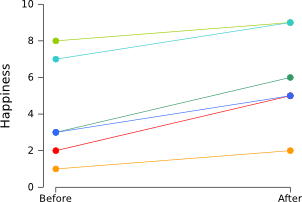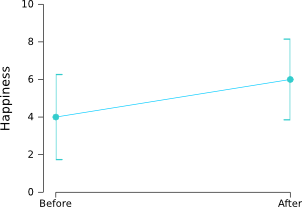Do you remember what it was like before the Internet? If not, just
Google “what was it like before the internet?” and you will.
In a recent study in Science, Sparrow and colleagues investigated
whether people indeed use the Internet as an external memory store.
This idea is not entirely new (in fact, it may be kind of obvious
that, in some sense at least, we do), but their experiments are quite
nice.
 The first experiment is most compelling, so I will give you a few
details. Participants were asked questions that were either easy or
difficult. After a series of questions, all of approximately the same
difficulty, participants performed a Stroop-like task. In this task,
participants had to name the colors of words. Like this:
The first experiment is most compelling, so I will give you a few
details. Participants were asked questions that were either easy or
difficult. After a series of questions, all of approximately the same
difficulty, participants performed a Stroop-like task. In this task,
participants had to name the colors of words. Like this:
Google Nike
Yahoo Shell
So that would be “red, green, blue, red”.
You get the point. The idea is that we are such overtrained readers
that word-meaning is processed before color. If a word is
particularly interesting, it will capture attention and interfere
strongly with the color naming-task. As a result, the response is
delayed for interesting words.
The crucial finding was that people are
slower to name the color of computer-related words (such as Google),
compared to control words (such as Nike), particularly after a series
of difficult questions. The authors concluded from this that when we
hear a difficult question, we don't think about the question per se,
but about how we are going to find out the answer. Which is typically …




![A globe (source: [url=http://commons.wikimedia.org/wiki/File:Globe.jpg]Wikimedia Commons[/url])](http://www.cogsci.nl/images/stories/blog/globe.jpg) Lewis and colleagues were quick to distance themselves from Morton's distinctly racist views, and emphasized that differences in cranial capacity do not reflect differences in intelligence, as Morton had believed. But this, of course, begs the question: If not intelligence, what do differences in cranial capacity reflect?
Lewis and colleagues were quick to distance themselves from Morton's distinctly racist views, and emphasized that differences in cranial capacity do not reflect differences in intelligence, as Morton had believed. But this, of course, begs the question: If not intelligence, what do differences in cranial capacity reflect?
 The first experiment is most compelling, so I will give you a few
details. Participants were asked questions that were either easy or
difficult. After a series of questions, all of approximately the same
difficulty, participants performed a Stroop-like task. In this task,
participants had to name the colors of words. Like this:
The first experiment is most compelling, so I will give you a few
details. Participants were asked questions that were either easy or
difficult. After a series of questions, all of approximately the same
difficulty, participants performed a Stroop-like task. In this task,
participants had to name the colors of words. Like this:
